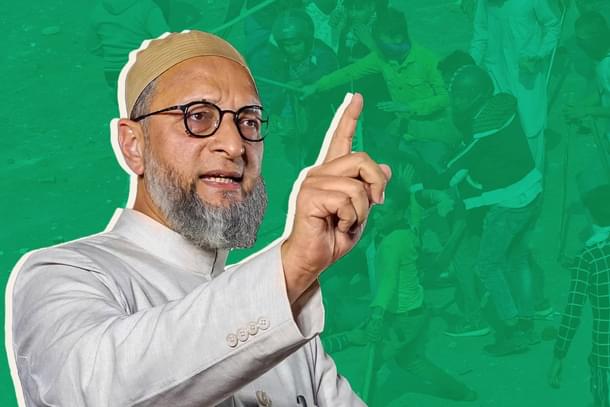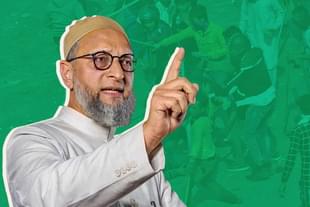Society
Evaluating Claims of Increased Mob Lynchings of Muslims In India: Where Is The Data?
Swati Goel Sharma
Jul 03, 2024, 12:11 PM | Updated 12:25 PM IST
Save & read from anywhere!
Bookmark stories for easy access on any device or the Swarajya app.


During the Lok Sabha proceedings on 1 July, AIMIM MP Asaduddin Owaisi raised the alarm over ‘increased lynchings of Muslims across India.’
He stated that mob lynchings of Muslims have increased since the Lok Sabha election results were declared on 4 June, claiming that six Muslims have been lynched since that date.
The same day, the CPI (M) party released a statement in New Delhi asserting that attacks on Muslims have increased after the Lok Sabha elections.
Party leader Jitendra Choudhary, while addressing a press conference, cited five deaths of Muslim men in Chhattisgarh, Uttar Pradesh, and Gujarat, and the demolition of 11 houses of Muslims in Madhya Pradesh, to support his statement.
Warning of street protests, the Communist party stated that “Hindutva forces are intensifying their attempts at polarisation with a renewed vengeance.”
Source of these claims
The figures cited by Owaisi and CPI (M) seem to have been derived from a few news portals such as Maktoob Media and The Wire.
In a report published three days earlier, ‘Maktoobmedia.com,’ a portal that covers Muslims, cited a recent case of the death of a man named Salman Vohra in Gujarat, claiming that “this is the sixth lynching incident after the results of the General Elections were announced on 4 June.”
The other five cases the report cited are:
- “Three Muslim men, residents of Saharanpur in Uttar Pradesh, were brutally attacked by a Hindutva mob in Chattisgarh’s Raipur on 7 June; two died on the spot, while one died after 10 days.”
- “Another Muslim man was beaten to death by a Hindu mob in Uttar Pradesh’s Aligarh.”
- “On 24 June, a Christian woman was murdered in Toylanka village in Chhattisgarh’s Dantewada after she and some of her family members had converted to Christianity.”
As one can see, the cases cited make a total of three incidents where five Muslim men were allegedly victims of mob lynching.
On the same day this report was published, controversial portal The Wire, which has been caught spreading misinformation and fabricated information on various occasions, published a report titled (translated) ‘A new wave of attacks on Muslims has started under the third term of the Modi government.”
This report cites the following seven cases to back the headline:
- The Chhattisgarh case as cited above in the Maktoob report.
- The Aligarh case as cited above in the Maktoob report.
- A case from Himachal Pradesh where residents vandalised the shop of a migrant trader from Uttar Pradesh named Mohammed Javed after he put a Whatsapp status showing himself slaughtering a cow on Bakrid, which police claimed was buffalo.
- A case from Himachal Pradesh where a Muslim trader was allegedly beaten up and asked to say ‘Jai Shri Ram.’
- A ‘gau rakshak’ group in Medak town of Telangana allegedly attacked a mosque after the managers bought cattle for slaughter on Bakrid. However, as per this Indian Express report, the violence was carried out by the Hindu as well as the Muslim side after a ‘gau rakshak’ group tried to stop a vehicle suspected of carrying cows for slaughter.
- A Muslim man was allegedly beaten up by a Hindu mob over allegations of dropping meat near a Hindu temple, in the Birbhum area of West Bengal.
- The Madhya Pradesh government demolished houses of 11 people after finding them accused of cow slaughter.
Is this data sufficient or balanced?
Now, the obvious question: is this really a credible database to claim that there is a trend of mob lynching of Muslims or even anti-Muslim violence since 4 June? Moreover, can three cases of attacks be sufficient to claim a narrative of a trend of anti-Muslim violence across India?
We looked at news reports to see if only Muslims have been targets of attacks in the same period. We found that this was not true at all.
- In Haryana’s Nuh district, which is almost wholly Muslim, a Dalit Hindu family was beaten up by their Muslim neighbours, allegedly for voting for the BJP.
- In Uttar Pradesh’s Jaunpur district, a Hindu man was attacked by a Muslim group after a spat over social media regarding political parties.
- In Uttar Pradesh’s Hardoi district, a Muslim mob comprising 10-15 people barged into the house of a Hindu family in the dead of the night and launched a surprise attack using firearms and sticks. A member of the family, Aman Rajput, died while several others were grievously injured.
- In Bihar’s Muzaffarpur, a minor Hindu boy was severely beaten up by a Muslim group so much that his arm was fractured. The attack was accompanied by demands that the boy chanted ‘Allahu Akbar’ and ‘Miyan Zindabad.’
- In Uttar Pradesh’s Pratapgarh, a Dalit Hindu man, named Vikas, was murdered by a Muslim group a day after he lodged a complaint against the molestation of his sister by members of the group
- In Karnataka, Boliyaru, two Hindu men, 41-year-old Harish and 24-year-old Nandakumar, were stabbed by a group of Muslim men. The victims were walking in a procession to celebrate NDA’s victory in the recent elections when the bike-borne attackers stabbed them
- A man named Salman Qureshi, hailing from an all-Muslim village of Muzaffarnagar district in UP, began frequenting a Hindu colony to molest women. Qureshi would threaten them with an acid attack if they complained. He was arrested after a video of the molestation went viral on social media
- Hindu residents of Balasore in Odisha, staging a protest against cow slaughter and drains turning red with blood on Bakrid, were assaulted by a Muslim mob.
These are only a few of the incidents where Hindus fell victim to communal attacks from Muslims.
In the same period, a bus full of Hindu pilgrims in Jammu and Kashmir, who had gone from various parts of India to visit the revered shrine Vaishno Devi, came under attack from a Jihadi terrorist group. At least 10 pilgrims lost their lives while more than 30 were injured.
Conclusion
The data cited by Owaisi and CPI (M) to support the claims of increased mob lynchings of Muslims is both insufficient and selective.
The incidents referenced by Maktoob Media and The Wire do not provide a comprehensive or balanced view of communal violence. The complete exclusion of cases involving Hindu victims, and lack of a broader context of communal violence, indicate that the narrative of targeted mob lynchings against Muslims is not supported by the available data.
Moreover, the selectivity of the claims made by Owaisi and CPI (M) raises concerns about the intent behind their statements.
By highlighting only specific incidents involving Muslim victims while ignoring similar or even more severe attacks on Hindus, these claims appear to be driven by a narrative that seeks to polarise and create a sense of victimhood among Muslims.
This selective reporting undermines the credibility of their arguments and detracts from the need to address communal violence in all its forms, irrespective of the victims' religious affiliations.
Additionally, the selective portrayal of incidents can potentially play into the hands of terror recruiters who exploit narratives of victimisation to radicalise individuals. By presenting a skewed version of reality, such claims can fuel resentment and alienation, providing a fertile ground for extremist ideologies to take root.
Swati Goel Sharma is a senior editor at Swarajya. She tweets at @swati_gs.





